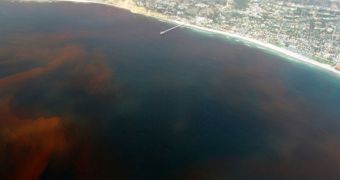Dead zones is a term used to describe areas of the oceans or seas that have been so heavily contaminated with pollutants, that it's virtually impossible for fish and other marine animals to live there. Only some types of algae manage to survive in the toxic conditions, and, by thriving, they consume the short supplies of oxygen that may have remained in the water. A new study, funded by the National Science Foundation, has determined that the number of dead zones around the globe is increasing by 100 percent every decade. Currently, more than 400 have been identified, LiveScience reports.
The situation is worse during the summer months, when virtually no lifeforms exist in these areas. And the dead zones are not covering just a few square miles around factories and river mouths, but hundreds or thousands of square miles of shorelines. They can also be found farther out into the sea, depending on how currents flow in the respective region. The NSF research has determined that the number (not the area) of dead zones in the world's oceans doubles once every ten years, which is a fast-progressing rate, by any standards. This means that pollution continues to flow unimpeded in the water, in spite of international pledges and stricter regulations.
Among the factors responsible for this situation, a huge role is played by agricultural fertilizers, which are extremely rich in nitrogen. As the spring comes, rain washes down these residues either into underground water streams, or in rivers. They are hence carried out to seas and oceans, where their concentrations spike. Good examples of growing dead zones are those in the mouth of the Mississippi River, as well as the ones covering half of the Gulf of Mexico, in the Southern United States. The large amounts of nitrogen that are emptied into the Atlantic are the main source of phytoplankton, tiny organisms that constitute the basis of the marine food chain.
As their food abounds, they bloom to massive levels. However, while this may seem like a good thing at first, it slowly turns into a nightmare as the organisms begin to die. As they decompose and fall to the ocean floor, they strip the waters of all traces of oxygen, which means that anything with gills, and a good portion of marine animals without them, can no longer survive. Another factor that causes dead zones consists of the changes in ocean circulation patterns, which scientists believe are caused by global warming. This has been most obvious since 2002 in the coastal waters of the Pacific Northwest.

 14 DAY TRIAL //
14 DAY TRIAL //